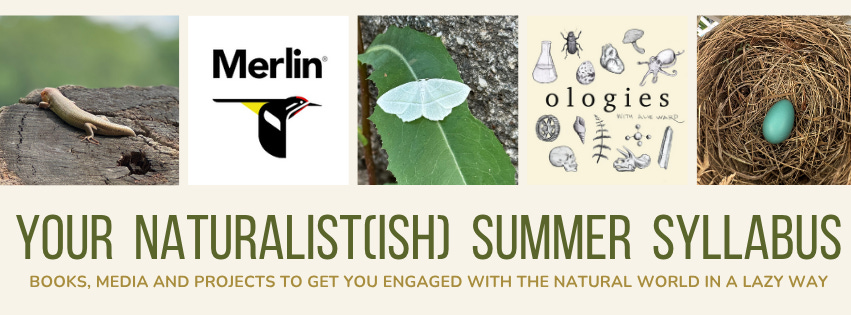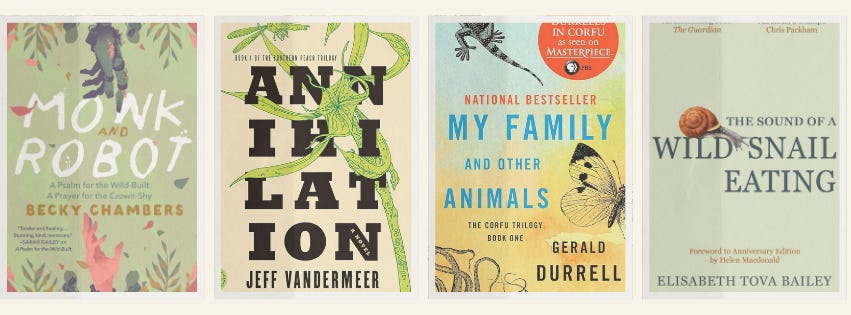This week I officially became a Master Naturalist. I graduated and got a name tag and everything. This is a huge accomplishment which I am extremely proud of, and also means absolutely nothing in the grand scheme of professional advancement.
I received my training through my county’s master naturalist program and I can honestly say it was the most fulfilling three months of my life. Essentially, I received a masters degree in earth science, squeezed into an intensive quarter of reading, lectures, and field work. With this training, I am now qualified for an entire world of volunteer opportunities in my community, and have become an ambassador for the natural world, helping people protect and love it the way I do.
Am I good enough to be a naturalist?
When I started, I was really daunted. I didn’t think that I had the chops to be a naturalist. Many of my classmates work at parks or have full-time careers working with nature, or spend every moment of their days volunteering. I didn’t think I was smart enough, or dedicated enough. I still feel that way, at times, but the only prerequisite to being a naturalist, in my opinion, is that you care enough to learn.
Loving nature and embracing its wonder should be accessible to everyone. And so, I present: My Summer Naturalist(ish) Syllabus, a collection of books, media and projects to challenge yourself with this summer.
This list is not for anyone seeking deep, intensive learning. This is for people who want to play with nature, to incorporate it into their life, who view nature as a fun companion and want to hang out with it like a friend.
I am not an overly academic naturalist. I am a sloppy naturalist, a lazy naturalist, a “ooh look at that bug” naturalist. I like the glory and nonsense of nature. The first step to loving the world you live in is to get to know it. So, here’s how you get to know it, low-key style.
Your Summer Naturalist(ish) Syllabus
Books:
Monk & Robot series by Becky Chambers
Want a simple little read? Look no further. The Monk & Robot duology is a gentle, cozy science fiction series that investigates the meaning of life, the responsibilities we have as caretakers of nature, the purpose of machines, and also robots. It’s a great, quick read that gets you thinking about caretaking and how durable nature is.
Annihilation by Jeff Vandermeer
The, dare I say, seminal work of ecological horror, Annihilation is a book I will never stop talking about. It follows a team of four women (a biologist, an anthropologist, a psychologist, and a surveyor) who set out into an area known as Area X, which is abandoned and cut off from the rest of civilization; they are the twelfth expedition, with all previous expeditions falling apart due to disappearances, suicides, aggressive cancers, and mental trauma. I first read this book while vacationing next to a wildlife preserve in North Carolina, and I think it permanently altered the way I think about ecosystems.
My Family and Other Animals by Gerald Durrell
The book that inspired my favorite TV show, The Durrells in Corfu, this is one of many memoirs by Gerald Durrell that details his childhood experiences and love of the natural world. It’s funny, irreverent, and makes you desperately want to find a gecko.
The Sound of a Wild Snail Eating by Elisabeth Tova Bailey
While an illness keeps her bedridden, Bailey watches a wild snail that has taken up residence on her nightstand. Intrigued by the snail’s molluscan anatomy, cryptic defenses, clear decision making, hydraulic locomotion, and mysterious courtship activities, Bailey becomes an astute and amused observer, providing a candid and engaging look into the curious life of this underappreciated small animal.
Backyard Bird Chronicles by Amy Tan
This is Amy Tan’s personal birding journal, recounting the highs and lows of backyard birding during the pandemic. I have recommended this book before, and will recommend it again, because Tan is incredibly relatable, and also incredibly unhinged in her bird obsession. The physical copy includes her own illustrations, while the audiobook is read by her.
Nature Obscura by Kelly Brenner
Kelly Brenner aims to help us rediscover our connection to the natural world that is just outside our front door--we just need to know where to look. Through explorations of a rich and varied urban landscape, Brenner reveals the complex micro-habitats and surprising nature found in the middle of a city.
A Sand County Almanac by Aldo Leopold
Few books have had a greater impact than A Sand County Almanac, which many credit with launching a revolution in land management. Written as a series of sketches based principally upon the flora and fauna in a rural part of Wisconsin, the book, originally published by Oxford in 1949, gathers informal pieces written by Leopold over a forty-year period as he traveled through the woodlands of Wisconsin, Iowa, Arizona, Sonora, Oregon, Manitoba, and elsewhere; a final section addresses the philosophical issues involved in wildlife conservation.
Podcasts and Youtube
Ologies with Alie Ward, also known as Ologies, is a weekly science podcast. Each episode, Ward interviews an expert from a distinct scientific field (somnology, bryology, philematology, etc.). It extends far beyon just naturalist topics, but you are always going to learn something. The most recent episode is about sustainable ocean foods!
In Defense of Plants is brought to you by ecologist and botany-enthusiast, Matt Candeias, and aims to inspire people to care about plants as organisms.
“A Low-Brow, Crass Approach to Plant Ecology & Evolution as muttered by a Misanthropic Chicago Italian.” The channel studies plants through the lens of ecology and evolution, rather than what supposed anthropocentric uses they can provide (as if holding up the biosphere wasn't enough).
A 5-part series documenting the lives of beavers and other animal and plant life in and around beaver ponds in northeastern USA. Beavers are so fascinating, and they’re also just goofy looking. I can’t recommend this series enough. The channel, New England Forests, also has loads of great videos to check out as well!
Kingdom of Plants by Sir David Attenborough
Kingdom of Plants is a natural history documentary series written and presented by David Attenborough, which explores the world of plants. It’s soothing, interesting, and makes a fantastic background video while you work or are trying to fall asleep. See how much plant knowledge you can obtain via osmosis.
Projects and field work
Sit outside in the grass for thirty minutes.
You may put a blanket down. Be by yourself. Write down what you see, or even just take a nap. The only rule: no phones or laptop or kindle. The point is to exist in nature without a screen distraction.
Download an identification app
Yeah, cocaine is neat but nothing beats the ability to be out with friends and tell them what kind of berry you’re looking at. There are so many identification apps out there, and I’ve used them all. Some I recommend are:
Birda: Like a social media birding app. It lets you identify and log sightings, but also helps you find the best spots to go bird and meet up with people!
Merlin: The mother of bird apps, Merlin allows you to record bird calls and will then identify what you’re hearing. Be warned that it’s not 100% perfect, so if you’re going to be a serious birder, don’t fully rely on Merlin for IDs. You still need a visual clue.
e-bird: The app for more serious birders. It lets you log every bird you’ve ever identified, and gives you tidy information about almost any bird you can think of.
inaturalist: The perfect app for the casual naturalist. It lets you log your photos, but also has a great identification algorithm. Just snap a picture, upload, and get a pretty accurate identification auto-generated!
Treebook: The authoritative guide to 100 of the most common trees in North America, right in your pocket. Never question a tree again.
Find out what kind of wetland you are. Then go visit it.
Yes, this is a plug for my previous post. But I mean it. Go find your spirit wetland and spend some time in it. Hold a mirror up to yourself.
Learn how to use dichotomous keys
Dichotomous keys are the step-by-step guide to identifying almost any organism you come across. Plants, trees, berries, animals, scat, even bones! If you find something while out and about, odds are good there is a dichotomous key somewhere on the internet that can help you identify it. Last month I spent an hour trying to identify a dead racoon skull. My sister told me immediately that it was a racoon skull, but using dichotomous keys I was able to know for sure. It feels good to work for something.
Share a picture of something you’ve found.
I mean it. Take a picture of that bug or weird plant. Post it on social media. Drop it in the group chat. Text it to your aunt. Spread the bug, man.
Go on a walk with a master naturalist
I once went on a frog walk with a professional naturalist who sort of looked like a frog. We didn’t find any frogs, and ended up just kind of watching some ducks dive bomb a pond. It was still an excellent use of my time because I got to visit a site I’d never been to before, see some ducks, and experience how infectious my guide’s enthusiasm was. Most of these walks will be offered through local parks, and will likely be free, so do some Googling and see what’s out there!
Lead a nature walk
Now that you know how to identify nature, are used to getting out there, and are learning how to observe, it’s time to share the learning. Take your friends, family, or unwilling audience of choice on a walk around nature. You don’t have to go to the woods—you can take a walk around your neighborhood. Identify as you go, showcase what you’ve learned, and ask each other questions. If you want to really level it up, bring a trash bag and some gloves and collect trash as you go.
Good luck! God speed! Do as much or as little of this syllabus as you would like. If you finish it all, you can make yourself a badge. Or, you can check out what volunteer opportunities exist in your community. Or even take it a step further and find out if there’s a master naturalist program near you. Odds are, they’re accepting applications.
Also, send me pictures of bugs.
-xx Bog Babe





